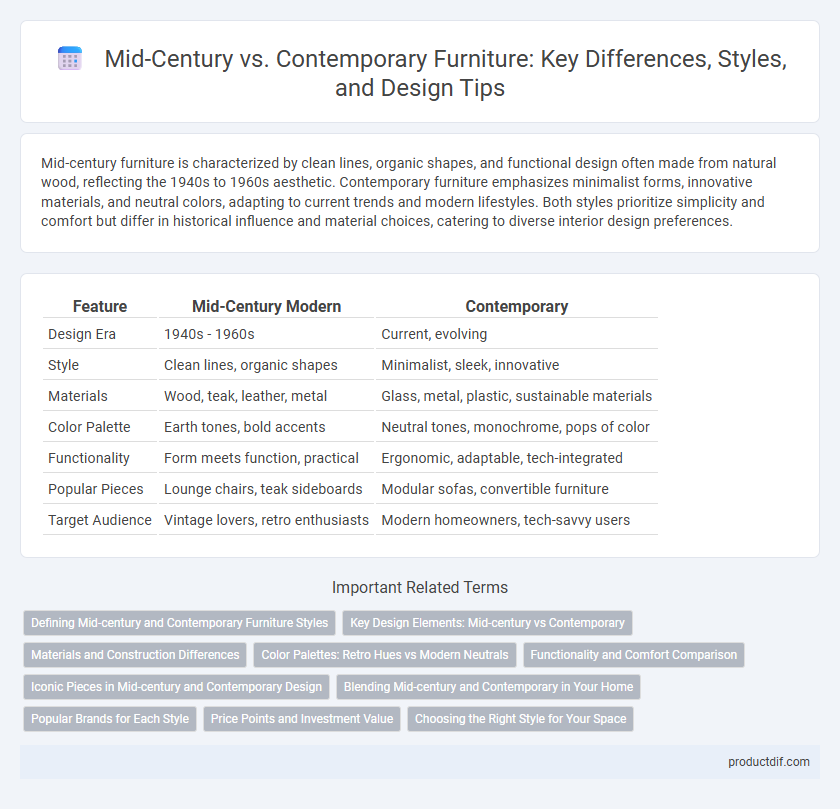Mid-century furniture is characterized by clean lines, organic shapes, and functional design often made from natural wood, reflecting the 1940s to 1960s aesthetic. Contemporary furniture emphasizes minimalist forms, innovative materials, and neutral colors, adapting to current trends and modern lifestyles. Both styles prioritize simplicity and comfort but differ in historical influence and material choices, catering to diverse interior design preferences.
Table of Comparison
| Feature | Mid-Century Modern | Contemporary |
|---|---|---|
| Design Era | 1940s - 1960s | Current, evolving |
| Style | Clean lines, organic shapes | Minimalist, sleek, innovative |
| Materials | Wood, teak, leather, metal | Glass, metal, plastic, sustainable materials |
| Color Palette | Earth tones, bold accents | Neutral tones, monochrome, pops of color |
| Functionality | Form meets function, practical | Ergonomic, adaptable, tech-integrated |
| Popular Pieces | Lounge chairs, teak sideboards | Modular sofas, convertible furniture |
| Target Audience | Vintage lovers, retro enthusiasts | Modern homeowners, tech-savvy users |
Defining Mid-century and Contemporary Furniture Styles
Mid-century furniture, originating from the mid-20th century, is characterized by clean lines, organic curves, and the use of materials like teak and walnut, emphasizing functionality and simplicity. Contemporary furniture reflects current design trends, often featuring bold shapes, mixed materials such as metal and glass, and a minimalist aesthetic focused on innovation and sustainability. Both styles prioritize functionality but differ in their historical context and material choices, influencing modern interior design preferences.
Key Design Elements: Mid-century vs Contemporary
Mid-century furniture design features clean lines, organic curves, and a functional form often crafted from warm woods like teak or walnut, emphasizing simplicity and natural materials. Contemporary furniture showcases sleek, minimalist aesthetics with an emphasis on metal, glass, and neutral color palettes, integrating innovative materials and advanced manufacturing techniques. Key design elements of mid-century contrast with the smooth surfaces and bold geometric shapes typical of contemporary styles, highlighting differences in texture, materials, and visual warmth.
Materials and Construction Differences
Mid-century furniture features natural materials such as teak, walnut, and rosewood paired with handcrafted joinery techniques including dovetail and mortise-and-tenon joints, emphasizing durability and organic aesthetics. Contemporary furniture often incorporates engineered materials like MDF, plywood, and metal frames combined with modern construction methods such as CNC machining and modular assembly, prioritizing versatility and cost-effectiveness. The contrast in material selection and construction reflects mid-century's focus on timeless craftsmanship versus contemporary's embrace of innovative, sustainable manufacturing processes.
Color Palettes: Retro Hues vs Modern Neutrals
Mid-century furniture embraces retro hues like mustard yellow, olive green, and burnt orange that evoke a vintage charm and warm ambiance. Contemporary designs favor modern neutrals such as shades of gray, white, and beige, creating a sleek, minimalist aesthetic that complements diverse interiors. The choice between these palettes influences the overall mood, with mid-century color schemes delivering nostalgia and vibrancy, while contemporary neutrals emphasize simplicity and sophistication.
Functionality and Comfort Comparison
Mid-century furniture prioritizes clean lines and functional design, often featuring ergonomic shapes that enhance comfort without excessive ornamentation. Contemporary furniture emphasizes adaptability and modularity, incorporating advanced materials and technology to optimize user comfort and practical use in modern living spaces. Both styles focus on usability, but mid-century leans towards timeless simplicity while contemporary embraces innovation for enhanced comfort and multifunctional living.
Iconic Pieces in Mid-century and Contemporary Design
Iconic mid-century furniture pieces, such as the Eames Lounge Chair and the Arco Floor Lamp, emphasize organic shapes and timeless craftsmanship, showcasing solid wood and molded plywood materials. Contemporary design icons like the Barcelona Chair by Ludwig Mies van der Rohe and the Noguchi Coffee Table blend minimalist aesthetics with modern materials like metal and glass for sleek functionality. Both styles prioritize comfort and innovation, but mid-century pieces highlight warmth and classic appeal, whereas contemporary designs focus on clean lines and futuristic simplicity.
Blending Mid-century and Contemporary in Your Home
Blending mid-century and contemporary furniture creates a dynamic balance between timeless design and modern aesthetics, featuring iconic mid-century wooden frames paired with sleek, minimalist contemporary pieces. Incorporating neutral color palettes and natural textures allows for a cohesive look, while statement lighting and sculptural accessories inject contemporary flair. Harmonizing these styles enhances spatial flow, making interiors both stylish and functional.
Popular Brands for Each Style
Herman Miller and Knoll are iconic brands celebrated for their mid-century modern furniture, known for clean lines and functional design that capture the essence of the 1950s and 1960s aesthetic. In the contemporary furniture segment, West Elm and Article stand out with sleek, minimalist designs that emphasize sustainable materials and modern innovation. Both styles maintain strong followings, but the choice depends on whether classic mid-century craftsmanship or cutting-edge contemporary trends align with your interior design goals.
Price Points and Investment Value
Mid-century furniture often commands higher price points due to its timeless design and collectible status, making it a strong investment with potential for appreciation. Contemporary furniture typically offers more affordable options and diverse styles, appealing to budget-conscious buyers but with lower long-term resale value. Collectors and investors prioritize mid-century pieces for durable craftsmanship and iconic aesthetics, while contemporary items suit those seeking trend-driven, cost-effective solutions.
Choosing the Right Style for Your Space
Mid-century furniture emphasizes clean lines, organic curves, and natural materials like teak and walnut, creating a timeless, warm atmosphere ideal for minimalist or vintage-inspired spaces. Contemporary furniture features sleek, innovative designs with a focus on functionality, often incorporating metal, glass, and neutral color palettes that complement modern, urban interiors. Choosing the right style depends on your space's existing decor, lighting, and personal preference for either classic warmth or cutting-edge sophistication.
Mid-century vs Contemporary Infographic

 productdif.com
productdif.com